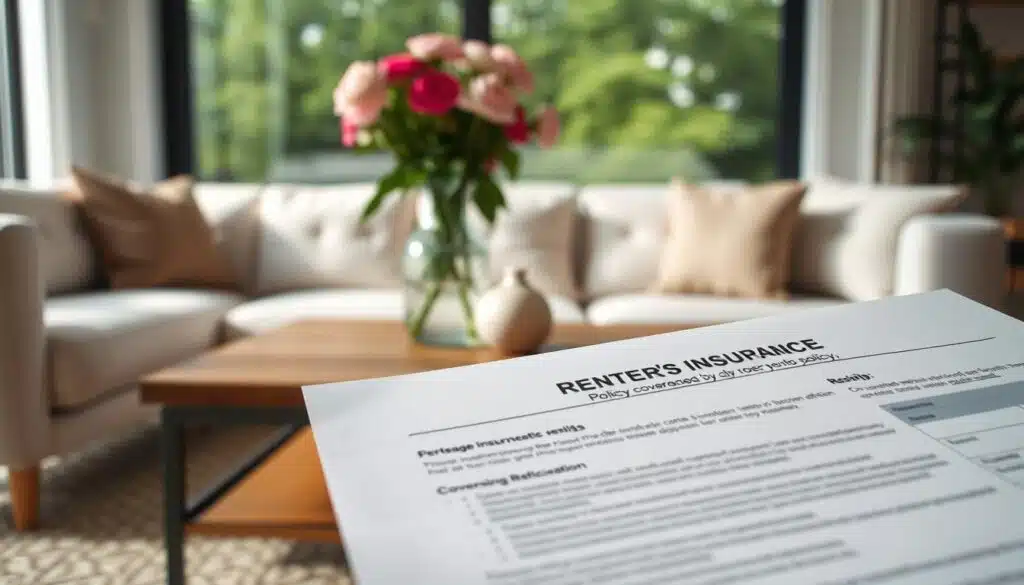Does Renters Insurance Cover Pet Damage? Typically, renters insurance won’t cover any damage your pet causes to your own property. But the good news is, it might help with liability if your pet injures someone else or damages their property. Think a scenario; if your dog damages your apartment? Your landlord might charge you. Renters insurance could help or leave you with a $5k bill. About 30% of renters in the U.S. have this insurance.
Many pet owners wonder if their insurance covers pet damage. The American Pet Product Association says 70% of American homes have pets. This is a big worry for many renters. In this article, we’ll talk about what pet damage insurance covers and how to understand your policy.
We’ll also share tips for dealing with insurance claims. Be careful; some policies have hidden exclusions and lists of banned breeds. Things you might not find out until it’s too late.
Table of Contents
ToggleKey Notes
- 70% of U.S. households have pets, making renters insurance pet damage coverage crucial.
- 30% of renters have insurance, but many don’t know what it covers.
- Basic liability coverage in renters insurance starts at $100,000.
- Pet-related claims can increase costs a lot, so understanding your coverage is key.
- Hidden exclusions and specific breed restrictions can affect your coverage unexpectedly.
The Importance of Renters Insurance for Pet Owners
Renters insurance is a key safety net for pet owners. It protects them from financial losses due to pet-related issues. With 67% of U.S. homes having pets, the need for pet-friendly renters insurance grows. Many landlords require it to cover damages pets might cause.
This insurance can help with costs from dog bites, which can be very high. It gives pet owners peace of mind.
Not having renters insurance can lead to big financial problems. About 30% of renters face pet-related damage costs. These costs can range from $500 to $2,000, making insurance crucial.
It also covers injuries to guests from pets, helping manage unexpected costs.
Renters insurance can help with vet bills if a pet hurts another pet. These bills can be $1,000 to $3,000. Even if some pet costs aren’t covered, insurance offers vital financial protection. This is important since more landlords are allowing pets.
The Short Answer: Does Renters Insurance Cover Pet Damage?
To know if renters insurance covers pet damage, you need to look at your policy. Usually, renters insurance does not cover damage to personal property from pets. But, if a pet hurts someone or damages a neighbor’s stuff, it might be covered under liability. This can pay for claims up to the policy limits, which can be $100,000 or more.
Most policies don’t cover damages from pets. They say damage from pests, including pets, is not covered. So, renters insurance for pet damage is mostly for liability cases. It’s important for pet owners to check their insurance well to know what’s covered.
Does Renters Insurance Cover Pet Damage to Carpet?
Most renters insurance policies don’t cover pet damage to carpets. This includes scratches from cats or holes dug by dogs. These damages are usually the renter’s responsibility.
It’s important for pet owners to know this. They should understand their renters insurance pet damage coverage. Liability coverage can range from $100,000 to $1,000,000. This helps with injuries to others or damage to their property, not the renter’s carpets or fixtures
Renters insurance mainly covers liability, not damages to the property. Replacing or fixing carpets can cost a lot. Knowing what pet damage renters insurance covers is key for pet owners renting homes.
Being aware of these limits helps renters avoid surprise costs. It’s important to understand these details to make smart insurance choices. This way, pet owners can avoid unexpected expenses from pet accidents or damages.
What’s Covered (and What’s Not)

Renters insurance is key for protection, but there are important details to know. It usually covers your personal stuff from theft, fire, and other dangers. But, there are things it doesn’t cover, like pet damage to your belongings. This is important to understand, as pets can cause big problems.
For example, if your pet hurts someone and they need a lot of medical care, you might not be covered. This is why it’s crucial to check your policy limits.
Also, renters insurance doesn’t help with damage from pets, like scratches or chew marks on your furniture. It also doesn’t cover temporary living costs if your place is damaged by pets. Knowing these limits can help you decide if you need extra coverage for pet damage.
It’s also important to remember that some pet breeds, like pit bulls and German Shepherds, might not be covered.
Understanding Renters Insurance Pet Damage Coverage
Renters insurance for pet damage is important for pet owners. Many policies have personal liability for pet incidents. About 60% of policies cover pet-related issues.
But, many policies don’t cover damages to personal property or the rental unit by pets. This is important to know.
Pet damage insurance can lower costs from pet claims. A pet claim can cost around $15,000. Policies usually have limits, like $100,000 to $300,000.
But, many pet owners don’t know about their policy’s pet coverage. It’s said 70% are not aware.
There are extra coverage options for pet owners. Adding pet liability coverage costs $10 to $30 a month. This is more important in shared living spaces. Some breeds might not be covered.
How to File a Claim Successfully

Filing a renters insurance claim can seem tough. But knowing the process is key to success. Pet owners must document damages well, like taking photos and getting witness statements. It’s important to talk clearly about the damage and how bad it is.
Having all the right documents helps a lot. It makes the claims process smoother and boosts your chances of getting your claim approved.
Many homeowners file claims each year. In 2021, 5.3% of homes with insurance filed a claim. It’s crucial to give accurate and full information. Claims with missing or wrong details often get denied.
Homeowners must try to prevent damage. Not doing so can also lead to claim denials. It’s important to file quickly. Renters usually have up to a year to file, depending on the insurer and state.
Getting help from a professional can be a good idea. Public adjusters can help with the process for a fee of 5% to 20% of the claim. Claim denials often happen because of missing evidence. So, it’s important to have good evidence like photos, videos, and witness statements.
Breed Restrictions & Exclusions to Watch For
Pet owners need to know about breed restrictions renters insurance might have. Some dog breeds, like Pit Bulls, Rottweilers, and Doberman Pinschers, are often banned. This is because they are seen as aggressive.
In 2023, there were 19,062 dog bite claims across the country, an 8.3% increase from 2022. These claims cost insurers $1.1 billion in 2023. This shows how important it is to know about these restrictions.
Knowing local laws is key. In places like New York and Illinois, laws prevent insurers from blaming just the dog’s breed. Renters insurance covers all household members, so pet owners are always responsible for their dog’s actions.
This is important because renters insurance usually only covers bites that happen in the apartment. Knowing this can help avoid surprises if a claim happens.
Does Renters Insurance Cover Pet Stains?
Knowing if renters insurance covers pet stains helps pet owners understand their duties. Renters insurance usually doesn’t cover damage from pets. It sees such damage as normal wear and tear, not as something to be covered.
Even though renters insurance might cover injuries from pets, it often doesn’t help with stains on carpets or other places. Some renters talk to landlords to share who will fix any damage. They try to find a fair solution.
Pet owners need to know what their renters insurance covers. If damage happens, like urine stains, they might have to fix it. It’s key to talk openly with landlords about these issues.
Many policies need extra coverage for pet damage. The standard liability might not cover pet-related wear and tear.
In short, pet owners should really get to know their renters insurance. It’s good for liability, but pet stains have their own rules. Being clear and planning with landlords is very important.
Pet Damage Renters Insurance: What It Can Cover
Pet damage renters insurance mainly covers liability for pet-caused damage. It protects against injuries to others. Most policies start at $100,000 for pet liability. This helps pay for medical costs from incidents like dog bites, which cost about $50,000 on average in the U.S.
Since 72 percent of renters have pets, this coverage is very important.
Standard policies offer a wide range of protection. But, some pets might not be covered due to breed or history. Dogs with a bite history might only have $5,000 in coverage, much less than the policy’s total. Insurance companies often don’t cover certain breeds like pit bulls and Rottweilers.
Specialized companies like InsureMyK9 and Dog Bite Insurance offer pet liability insurance. But, many big national insurers don’t. This means pet owners need to carefully look at their options.
When You’ll Need Extra Coverage

Renters insurance usually has a liability limit of $100,000. This might not be enough for pet owners. The average dog bite claim in the U.S. is almost $45,000. This is why renters insurance extra coverage is key, mainly for pet owners with aggressive pets.
Owners of certain breeds might need more insurance. They should look into additional pet insurance or endorsements. This will help increase their coverage limits.
Pet owners in rentals where damages might go over standard coverage should look into these options. Renters insurance doesn’t cover damages from pets, like a dog chewing furniture. The monthly cost of renters insurance is about $13. It’s affordable to increase your liability limits.
Experts say you should think about a higher liability coverage limit, at least $300,000. This upgrade costs just a few dollars more each month. It gives you a safe safety net.
It’s also important to know what renters insurance doesn’t cover. It doesn’t cover injuries your pet might cause or damages to your property. Knowing this helps manage risks better.
Renters Insurance vs. Standalone Pet Liability Policies
When you think about renters insurance vs. pet insurance, it’s key to know the differences. Renters insurance often covers pet liability for dog bites, but not for pet damage. It usually has a max of $100,000 for claims, but dog owners might need more, like $500,000. Renters insurance costs about $12 a month, but it doesn’t cover pet damage.
Standalone pet liability policies, on the other hand, are all about pet damage and injuries. They can cost as low as $10 a month, with coverage from $10,000 to $30,000. But, they might have high deductibles, from $250 to $2,500. Some breeds, like Rottweilers or German shepherds, might not be covered.
If your pet often damages property, a standalone policy might be better. But, getting both renters and pet liability from one company can save money. It’s smart to know the pros and cons of each to make the best choice.
Real-World Examples of Pet Damage
Pet damage is a big deal. It shows why renters insurance for pets is so important. Dogs chewing on walls and cats scratching furniture are common problems. These issues usually cost the owner money.
When pets hurt people, like a dog biting a guest, insurance helps pay for medical bills. Dog bites can cost over $50,000 on average. This shows why good insurance is key to avoid big bills.
Renters insurance also covers liability for pet accidents. But, pets can still cause damage that leads to big claims. Some pets might not need extra insurance because they don’t cause much damage. But, some breeds might not get covered at all.
Damage can lead to repair costs and legal fees. It’s important for pet owners to check their insurance. They need to make sure they’re covered for unexpected problems.
Conclusion
Renters insurance is very helpful for pet owners. It gives them important protection against pet-related damages or injuries. But, it’s key to know that coverage for pet damage to personal property can vary.
Most renters get up to $100,000 in personal liability. But, the Insurance Information Institute (III) suggests getting at least $300,000. This is because the average cost of a dog bite claim is close to $45,000.
Renters insurance for pets can be different. Some policies might not cover certain breeds or situations. Homeowners might need extra riders or endorsements for pet-related issues. This is because many policies don’t cover normal wear and tear.
It’s smart to train pets and use protective coverings. This can help avoid expensive claims.
Knowing your policy well is very important. It helps protect you from the financial impact of pet-related issues. By being proactive and choosing the right coverage, pet owners can keep their homes safe and secure.










